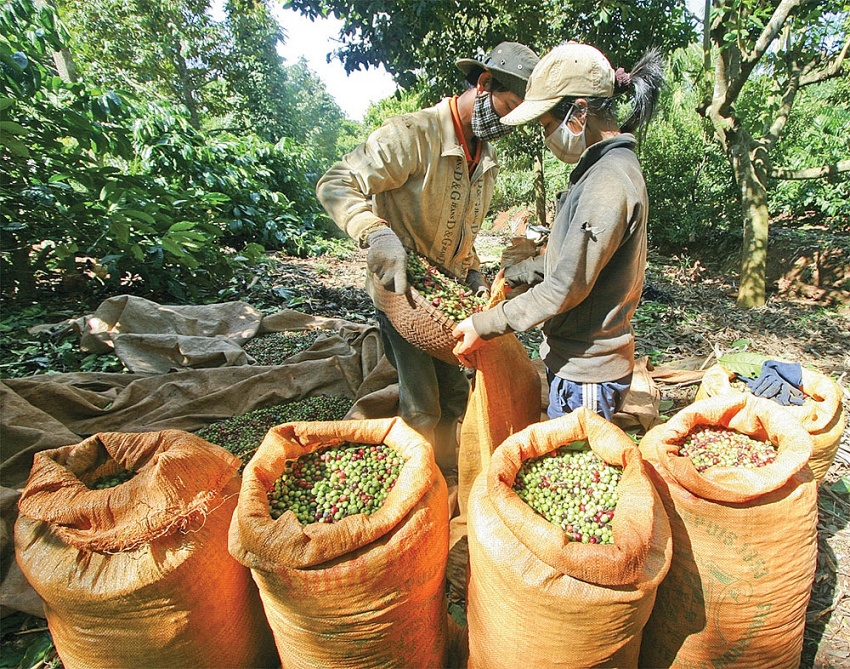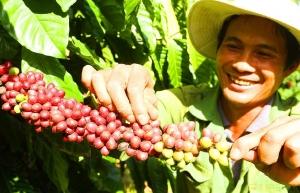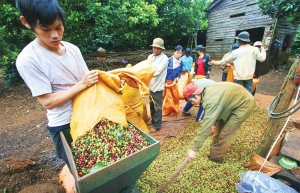Supply pressures ahead for Vietnam’s coffee exporters
 |
| Supply pressures ahead for Vietnam’s coffee exporters, Photo: Le Toan |
According to data from the General Department of Vietnam Customs (GDVC), the country counted $1.93 billion from coffee export in the first quarter of this year, setting the sector’s record in terms of export value. Despite just a 4.9 per cent hike in the export volume compared to one year ago, export value showed a 57.3 per cent jump thanks to a spike in the export price.
With this result, coffee export turnover reached its highest level in Q1, becoming one of the agricultural export products with the strongest growth.
In a trading session on April 19, coffee prices in the domestic market set a new peak when reaching VND122,100 ($5) per kilogramme, an increase of more than 5 per cent compared to the previous day.
Forecast price fluctuations in Vietnam have not yet achieved stability because many experts predict that domestic coffee prices may increase to $5.20 per kg, while international coffee prices are also difficult to predict in the days of constant change.
Le Duc Huy, general director of Simexco DakLak, one of the top three coffee exporters in Vietnam, said that export turnover could reach a record this year.
“We are witnessing a significant situation in the Vietnamese coffee industry. Ten years ago, coffee export turnover only reached $2 billion, in 2023 it will reach a record of more than $4 billion and this year it can conquer $5 billion,” Huy said.
Rising prices
Despite the high increase in value and open export opportunities, coffee growers, purchasing agents, and raw coffee export businesses benefit very little from this price increase as the coffee supply is not guaranteed.
Nong Van Duong, a coffee farmer in Krong No district of the Central Highlands province of Dak Nong, said that his family’s 1.3ha coffee growing area had been sold out since the coffee price reached $2.5 per kg, about 20 per cent higher than the average annual purchasing price.
“Now the price of coffee has doubled, which I regret,” Duong said. “Last year’s coffee crop failed, and investment costs increased. My family’s garden only harvested about three tonnes, so when I saw a better price, I sold it all.”
According to Thai Nhu Hiep, director of Vinh Hiep Co., Ltd., one of the top raw coffee exporters in Vietnam, the continuous fluctuation in green coffee prices has pushed businesses into the fear of having to temporarily extend suspending exports due to depleted supplies.
He admitted that the company’s inventory was only enough to sell until May, while the new coffee harvest would not begin until October.
“We plan to stop exporting early because we have run out of goods. This is unprecedented because in previous years, the company would have enough goods to sell until the end of the season, around August to September,” Hiep said.
General director of Simexco DakLak, Le Duc Huy, said that although the price of input materials had increased, it was difficult for exporters to raise product prices because orders have been signed in advance. Some businesses had to accept purchasing at high prices and selling at a loss to maintain credibility with international partners.
Simexco DakLak exported a record coffee output of over 19,450 tonnes in March. However, the business expects the company’s 2024 coffee export output to decrease by about 10 per cent compared to the previous year, from 125,000 to 105,000 tonnes a year.
“The amount of coffee stored in coffee growing households and traders has also been depleted. Only when we can ensure supply will we sign more export orders with partners,” Huy said.
Foreign advantages
As domestic coffee prices rice, foreign-invested enterprises (FIEs) with the advantage of abundant capital have stepped up purchasing and increased their proportion in total coffee export turnover in recent years.
Data from the GDVC shows that the amount of coffee exported by FIEs in the first quarter of this year reached the highest level in many years with over 187,100 tonnes, an increase of 15.5 per cent over the same period last year and higher than the overall industry increase of 5.9 per cent. Meanwhile, the amount of coffee exported by domestic enterprises increased by nearly 2 per cent, reaching almost 399,000 tonnes.
The proportion of FIEs in Vietnam’s total coffee exports also increased from 26.7 per cent in the first quarter of 2022 to 32 per cent by the end of the first quarter of 2024. Although domestic enterprises still account for a large proportion of 68 per cent, they have shrunk by nearly 5 per cent compared to the same period in 2022.
Do Ha Nam, vice chairman of the Vietnam Coffee-Cocoa Association (Vicofa), said that in the 2023-2024 coffee crop, FIEs bought coffee starting from June 2023 when coffee prices were still low, while Vietnamese coffee exporters buy after harvest, starting from October-November 2023.
“The huge price difference between the two times has caused many risks, and this is a big lesson for the next crop,” he said.
Vicofa also forecasts that Vietnam’s coffee output in the 2023-2024 crop will decrease by around 20 per cent due to reduced productivity and many coffee growing areas being converted to other crops. In the 2022-2023 coffee crop, Vietnam had to import 200,000 tonnes of coffee due to a shortage of domestic supply.
Although they have been proactive, not all FIEs have gained a price advantage. Many businesses have had to switch to buying robusta coffee from other markets because some Vietnamese suppliers cannot deliver according to the contract.
Nguyen Dang Mien, a representative of Nestlé Vietnam, said that due to broken raw material supply chains, Nestlé was forced to import raw materials from other countries in the past two years, even though it has built a sustainable coffee initiative in Vietnam since 2011.
“To ensure the factory operates regularly, since last year, Nestlé had to import coffee instead of Vietnamese coffee. We hope for a stable supply to continue to be the leading buyer of Vietnamese coffee,” Mien said.
At a meeting organised by Vicofa two weeks ago, some FIEs also warned that if the situation persists, roasters around the world might switch to buying coffee in other countries.
B. Aditya, purchasing manager of CCL Products India Ltd, India’s leading Instant Coffee Manufacturer, said, “We are currently changing our coffee import strategy to replace Vietnamese robusta coffee. This is something the company did not foresee. The whole industry chain is being disrupted and this will greatly affect Vietnamese coffee.”
According to Vicofa, in the first six months of the 2023-2024 coffee season, which covers to the end of March, Vietnam exported more than 955,000 tonnes of coffee, and the value reached more than $3 billion.
 | Cost increase issues put coffee purchasers on alert Global supply tensions are driving the world’s coffee export prices to high levels, with supply shortages potentially beneficial to large coffee-exporting countries like Vietnam. |
 | Potential price hikes weigh on top coffee chains Everyday coffee habits may have to be cut back as beverage outlets consider plans to increase prices to compensate for the increase in raw coffee. |
What the stars mean:
★ Poor ★ ★ Promising ★★★ Good ★★★★ Very good ★★★★★ Exceptional
Related Contents
Latest News
More News
- Dat Bike accelerates sustainable mobility (January 07, 2026 | 15:24)
- Innovation to support modern healthcare development (January 07, 2026 | 10:00)
- Six localities record double-digit growth as regional performance diverges in 2025 (January 06, 2026 | 18:00)
- E-commerce market undergoes transformation amid rising competition and regulation (January 06, 2026 | 17:54)
- Vietnam’s industrial output hits seven-year high in 2025 (January 06, 2026 | 17:47)
- GELEX’s credit rating outlook upgraded to 'Positive' by VIS Rating (January 06, 2026 | 16:49)
- Finance sector lays firm groundwork for 2026 after major reform (January 06, 2026 | 15:30)
- Vietnam’s seafood exports surpass $11 billion in 2025 (January 06, 2026 | 08:51)
- Vietnam GDP posts second-strongest growth since 2011 (January 06, 2026 | 08:35)
- Double-digit GDP growth within reach with shift to higher-value expansion (January 06, 2026 | 08:33)

 Tag:
Tag:



















 Mobile Version
Mobile Version